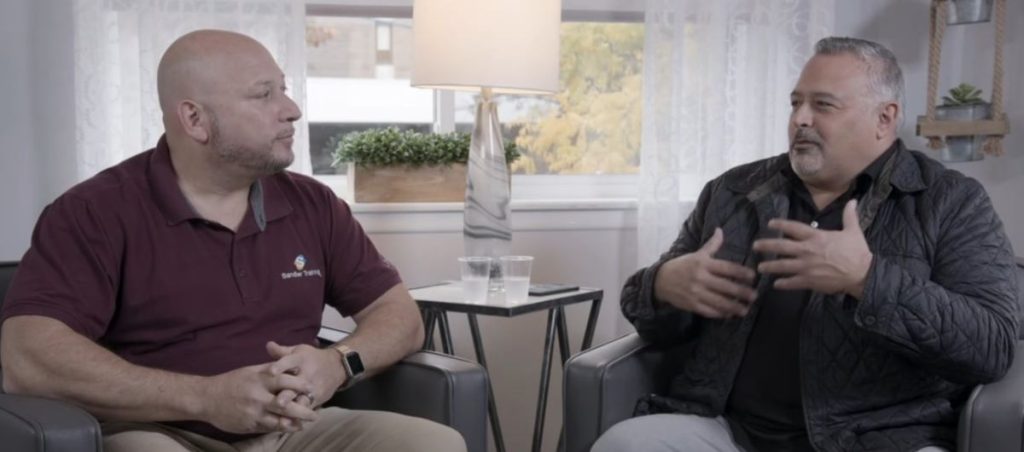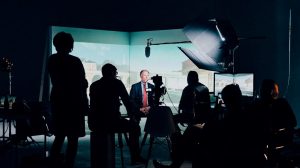Hi, My name is Tom Ranieri and I’m the owner and creative director of an award winning video agency called Postcreatives. In my career I have interviewed several hundreds of CEOs, Sales Executives, Business Owners and Captains of their Industry – all over the world in my 35+ years in the video production business!
I have created this specific video to help sales people and organizations of all kind get the competitive advantage they need to point blank help them to make more money!
I hope you get tremendous value out of this Interview I conducted with Scott Bliss of Sandler Training. Scott is a franchise owner of Sandler Training, an award-winning sales trainer, and a national speaker. So it’s safe to say he’s an industry-leader who really knows his stuff, and the perfect person to bring this valuable exercise to the table.
I know that if you practice these principles in all of your business affairs it will bring you much success!
Best,
Tom
Here is the transcription of the entire Interview so that you can see the words that were carefully chosen by Scott for this training exercise…
Tom Ranieri:
Hi, I’m Tom Ranieri and we here today with the very first One on One with Tom Ranieri show. We’re going to be trying to come to you at least once a month with great sales tips, great sales training and other ways to enhance your business other than just using video. I’m here today with Scott Bliss. Scott and I have gotten an opportunity to know one another over the last several months. Scott is my Sandler trainer and his training has been fantastic. I absolutely love it and getting an opportunity to meet Scott and know him a little bit. You have a lot of fun when you go to his classes as well. So it’s not just about learning about sales and business, but he puts a lot of fun into it as well. So let me just, Scott, if I can, I’m to introduce you, have a little something written for you.
Scott Bliss:
Please. Please do.
TR:
Okay. Scott Bliss is an award winning Sandler trainer, and is a recognized business development expert specializing in executive sales, consulting in sales productivity training. Scott is also a dynamic speaker who informs and entertains, motivates presidents, CEOs, sales leaders, and sales professionals. So in other words, Scott also will come to your event and he’s an excellent motivational, and sales trainer, and speaker on a national scale. So… Hey listen, we don’t know if this shows going to work. But hey, thanks a lot for coming and being on, I appreciate it.
SB:
I’m very pleased to be the inaugural guest.
TR:
I hope this brings a lot of value to the people who are going to be watching this out into the LinkedIn world and in other places. Essentially, what I really want to do here is I want to give value. We always want to bring value to the business world, right? So what we’re going to try to do is, we’re going to try to give tips on how you guys out there could take the information that you’re going to learn here today and immediately put it into your sales, into your organization, and have it making an immediate impact. So essentially we want to help you make more money-
SB:
Absolutely.
TR:
… immediately. So if we can, I just have a couple of notes here. So I think what we want to do, is we want to teach the people out there today how to develop your 30 second commercial. Right? And how that parlays into more sales. Right?
SB:
Right.
TR:
So Scott, maybe you can kick this whole thing off by telling me what are the most common challenges most organizations face when it comes to sales?
SB:
Sure. Thank you for asking. Many clients come to us and a lot of the common challenges they face have to do with uncovering enough new prospects on a consistent basis. Also, stagnant sales pipelines. A lot of the business owners we deal with, they are frustrated that sales pipelines have become stagnant. But more importantly as well, they’re concerned because quotas are not being attained on a consistent enough basis. Salespeople are not making their numbers. There’s a number of reasons why this might occur, as we delve into it a little bit deeper.
SB:
But to get back on point to 30 second commercials, I mean it’s a very old technique. The 30 second commercial, or most commonly referred to as an elevator pitch, has been around for a very long time. And we’ve been to enough meetings, enough networking events, we’ve gotten enough cold calls and different other types of phone calls where I think a lot of times people just mail it in. They get up there and they deliver a commercial that really does not resonate with anybody. And they just kind of… Just the way they deliver it without passion, without enthusiasm. And they think that everybody in the room already knows what they do, so why did I need to go through saying it? So what we’ve done at Sandler is, we’ve come up with a new spin on a very old technique really, and we call it FUDWACA. It’s a weird word, but it’s a pain inducing- [crosstalk 00:04:08]
TR:
I had a very hard time. I would sit in class all the time and at the end of the class I would say, “Scott, I’m just not getting FUDWACA. I’m just not getting it.” And I thought, I was like, “I’m pretty sharp guy,” you know, but I wasn’t getting FUDWACA. So maybe you can… What does FUDWACA mean, and how does it resonate, how does it help with the 30 second commercial?
SB:
Sure, sure. So FUDWACA, it’s a very painful word. It’s an acronym. The F stands for frustrated. The U is upset. The D is disappointed. The W is worried. The A is angry. The C is concerned. And the last A is anxious. When you use these types of words, they invoke some type of response from the audience that you’re speaking to.
SB:
So for example, I work with business owners, CEOs and sales leaders who are frustrated that sales quotas are not being met on a consistent enough basis. So if you’re in the room and you’re a business leader or a sales leader, and you’re having those types of issues, you probably are frustrated. So you might perk up a little bit and say, “Yeah, that’s me. I’m frustrated.” Other people I deal with are upset that sales pipelines have become stagnant. As that business owner, again, I’m sitting there thinking, yes, yes. Why are these things taking so long to close? Our sales cycle was never this long. Why all of a sudden are these things taking so long?
SB:
And other clients of ours, they’re disappointed that their salespeople are not developing enough new prospects on a consistent basis. So right there I used frustrated, upset and disappointed. Those are words that are going to invoke some type of emotional response from the audience. And if there’s a business leader in the audience at that point in time, in the room, they might sit there and say, “This really resonates with me because I’m having that issue with my sales team. We’re not uncovering enough new leads. We’re not closing business quick enough. We’re not making sales quotas, which means my salespeople are not making commissions, which means I’m not making my bonus.” So these are pain inducing words that we use to describe common everyday problems. [crosstalk 00:06:25]
TR:
When I came into your class, I was very old school. I’ve had sales training in the past and everything was about features and benefits.
SB:
Yeah.
TR:
And you know, we would regurgitate on yourself. We would try to, of course, listen. We’re storytellers at heart and in order to be a storyteller you have to listen. You know, God gave us two ears and one mouth for a reason. You have to listen. Right? And then we would combat that listening with either coming up with a great story or try to punctuate features and benefits. In today’s world, right? Today, everyone, you have to… In order to add value, what I hear you saying is you have to solve their problems.
SB:
Yeah.
TR:
Instead of selling with features and benefits, you have to solve their problems.
SB:
Yeah. I mean we were, long ago, features and benefits, that was it. I was brought up learning, features tell, benefits sell. And you want to get out there and you want to educate your customer, your prospect. You want to educate them so they can make a good decision about what product or service they’re going to buy. That’s not necessarily the case anymore. We have a rule at Sandler that says, sell today, educate tomorrow. And the way that you’re going to ingratiate yourself with your prospect, and really make a difference and stand out in a very crowded and competitive environment, is to ask enough questions where you can uncover their need, their want, their pain, as we call it in Sandler. Uncover their pain and try and solve it. That’s when you build a stronger rapport with a client. When you go in there with the mindset that I’m here to potentially solve a problem that you might have. I’m not here to sell you what I want to sell you. I’m here to sell you a potential solution to a problem that you might be having. And that’s the mindset that you have to have.
TR:
One of the things that I’ve learned from Scott is that he keeps telling me that I have to get comfortable being uncomfortable. And I was like, “Why do I need to be uncomfortable? I want to be suave. I want to be the man…” But it’s getting uncomfortable with asking really tough questions. You know, how many times have you gone into a sales presentation where you felt like, “Wow, I had a great meeting, I was on.” And then you walk away either getting ghosted, or in a proverbial followup, or you didn’t maybe get the information that you really needed in order to close the deal. But let’s talk a little bit about getting comfortable being uncomfortable, if you don’t mind.
SB:
Yeah, no, absolutely. I mean, we feel as salespeople that we have to be subservient to our prospect, to our customer, because they’re taking the time to see us. And we’re interrupting them in the middle of their busy day, and they’re taking the time to see us. What we teach at Sandler is a mindset of equal business stature. They might be the CEO of the company that you’re meeting with, but you’re the CEO of your own business. And if you’re a sales rep, and you are responsible for a territory, don’t look at yourself as a sales rep. Look at yourself as the CEO of your territory. Your time is just as valuable and just as important as your prospect. Equal business stature. That’s what you have to really think about and feel it. And you’re there for a reason. You’re there to determine if you have a solution for their problem. And the only way you can do that is by asking them questions.
SB:
And you’re going to ask them questions about what they’re currently doing. Why is it not working? What have they tried to do about it? How committed are they to fixing the issue? So on and so forth. And you really have to ask these types of questions that make your prospect think. And a lot of times too, by asking these difficult questions, ones that you wouldn’t ordinarily ask, you’re also differentiating yourself from the competition. Because many times the untrained sales person is [inaudible 00:10:18] going in there, and doing the show up and throw up.
TR:
I can’t tell you how many times Scott has helped me incorporate, help me to ask the right questions and incorporate it into my sales process. And I would call him later and say, “Man, I was cringing when I asked X, Y, Z question. But then they would be like, wow, that was a great question. No one’s asked me that before.” So I’m getting a lot of that lately. So it is true. I want to get back to developing the 30 second commercial because that parlays into potential cold calling, email scripts, networking events, how you introduce yourself at an event, verbiage that goes on your website. A 30 second video commercial, right? Where you might… You know, there’s so many different applications for cultivating and developing a powerful 30 second commercial.
SB:
Right.
TR:
So can you elaborate a little bit on-
SB:
Sure.
TR:
… that please.
SB:
Sure, absolutely. With your 30 second commercial, you want to take note of your audience. Who’s in the room? Is it CEOs? Is a business owners? Is it other sales leaders? Is it… Depending on your environment, your business, and your industry, and you want to talk to those people. So you want everybody to know who you work with.
SB:
For instance, for me, I work with CEOs, business owners and sales leaders. Those are the main people that I work with. So I start off my 30 second commercial by saying that’s who I work with. Then I go right into FUDWACA. It tells what I do. I work with these people that are frustrated because sales pipelines are stagnant. They’re concerned that their sales quotas are not being met consistently enough, and they’re worried that their people are not uncovering enough new prospects on a consistent basis. So right then and there I’m addressing three very big problems that occur in my industry where sales leaders have these concerns. So if you’re not a sales leader and you don’t have that concern, it may not resonate with you what I’m saying at that point in time. But you want to make sure what you say resonates with your audience.
SB:
So you can get up and you can deliver that at a networking event. And you don’t want to assume that your audience is having these problems, but you might say something to the effect of, “I’m not sure if any of you are experiencing any of these issues, but if you are, maybe we should have a conversation.” I can’t tell you how many times people seek me out at the end, after we deliver those 30 second commercials because it resonates with them. But now how can you take that and parlay that into a cold call? Very easily. It’s the same technique.
SB:
You just switch it up a little bit, because we are all tasked in the sales world of having to make cold calls. Nobody likes to make them. People that tell me they like to make cold calls, I think they’re lying. Nobody likes to make them, nobody likes to get them. So we teach an approach, a technique, called the no pressure prospecting call, how to really take the painfulness out of the call. And a lot of times we all get these telemarketing calls, and we pick up the phone and right away somebody says, “Hi Scott, how are you? This is Bob from ABC company and I’m calling the solicit money from you for our nonprofit. And here’s what we do with our nonprofit. We do this, and we do this, we do this.” And all they’re doing is talking. A lot of times we just hang up on them. If it doesn’t resonate with us, if it’s not something we’re interested in, we’re going to hang up the phone.
SB:
What we do is, we take a spin on that 30 second commercial. We get you involved in that phone call right away. So if I’m calling up you, Tom, and you answered the phone, “Hi, this is Tom.” I’m going to say, “Tom, my name’s Scott with Sandler Training. I’m not sure if you’re familiar with my name or my company.” What that is, it’s a pattern interrupt. It gets Tom involved in the conversation right away. And he might say, “No, sorry, I’ve not heard of your name or your company.” To which I might respond, “That’s okay. I didn’t think you would. Tom, is it okay if I take 30 seconds to tell you why I’m calling you today? And at the end of that 30 seconds, if you have no interest in learning anything more, it’s perfectly okay to hang up.”
TR:
I want to ask a couple of questions, if I can. Self-serving a little bit.
SB:
Sure.
TR:
So I’m the video expert.
SB:
Yeah.
TR:
And we recently had an opportunity to do some videos like this for you and your organization, using these exact methods. I’m going to put you on the spot because we didn’t talk about this in advance.
SB:
Sure.
TR:
The video probably only came out maybe 30 days ago or less, but have you implemented the video using these methods? And have you had any immediate success taking this 30 second commercial and in combination with some testimonial from the customer, and client, things like that. Tell me, how has the 30 second commercial worked for you in combination with video?
SB:
Right. So the video you shot for me is what you’re- [crosstalk 00:15:35].
TR:
Correct, right.
SB:
Yeah. So the video you shot, obviously I put it on my social media, I put it on my LinkedIn, I got quite a few likes. To me that’s a warm lead. If somebody I either know, or even if I don’t know them, if they comment or like my video that’s an opportunity for me to contact them and say, “Tom, thanks for liking my video. Tell me, what was it about it that resonated with you?” It’s a door opener. It gets me in. It gets me in a conversation. It’s a great thing to use, a great tool to use for people that you don’t know. We all have connections on LinkedIn, on Facebook, that we don’t necessarily really truly know these people well. But if they’re going to comment or like your posts, or your video, and specifically that we’re talking about here, that is a door opener.
TR:
It’s like a warmer [crosstalk 00:16:30] lead rather than just making a complete cold call.
SB:
Absolutely. And you start off maybe by sending them a quick message back. “Tom, thanks for liking my video. What was it about it that you liked?” Maybe they answer back. Maybe it leads to a five minute introductory phone conversation, at the very least. If you don’t have an opportunity with that individual, maybe you can ask them for a referral. Somebody they think that your services might be able to benefit.
TR:
Great. So I was hoping that we created great value here today. I also don’t want to bore the people on the first time out.
SB:
Sure.
TR:
So I want to try to keep it, I guess, semi short. Again, we’re doing this all as a test. But tell me, if someone’s out there watching this and they’re interested in what you had to say today about developing and cultivating a 30 second sales pitch, FUDWACA, where are the resources? Where would you tell them they can go to get more information about this? And I know you have a class, so maybe you even want to give them an introductory session to your class. I don’t know. I’ll let you speak to that, though.
SB:
Absolutely. We have public training classes where people from different [verticals 00:17:41] come in and they sit in on our weekly sessions. I invite any of you out there that want to check us out, you can crash one of our classes, absolutely on me. Be happy to have you as my guest. You can also go to our website, it’s maximumperformance.sandler.com. Or I could be reached at 732-255-6672. And our email as well, is scott.bliss@sandler.com. You can find us on LinkedIn. You can find us on Facebook. We’re Sandler Training by Maximum Performance Management.
TR:
Scott, I want to thank you for being, again, the first guest on the one on one with Tom Ranieri show. I hope you had a lot of fun.
SB:
Absolutely.
TR:
And I hope your phone rings off the hook as a result of providing such great value, sort of LinkedIn and other community social media communities out there. Thanks a lot.
SB:
Thank you, Tom.









